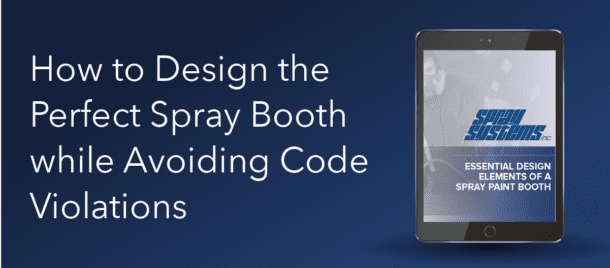Read Time: 4 minutes
Summary:
- Automated booths aren’t appropriate for all workplaces, so operators should consult with booth manufacturers to find the best fit for their particular needs.
- Selecting and optimizing an automated spray paint booth requires intimate knowledge of the production process, including the desired quality of finish, the rate of production and dimensions of the products or materials being painted.
- Most automated spray and finish booth systems fall into one of several broad categories: synchronous (best for repetitive, high-volume production lines), non-synchronous (offer more flexibility and less downtime for booth adjustments), single station (often the most affordable and practical option) and continuous (good for dealing with extremely high volumes).
- Automated booth systems can help to limit safety risks, reduce resource waste, ensure consistent spray application and lower operating costs.
- Production processes that involve significant volume and frequent repetition are promising candidates for robotic and machine-assisted automated booth systems.
- As a comprehensive provider of conventional and automated spray booth systems, Spray Systems works with customers to select the booth that best meets their needs, as well as helps customers integrate automated booths as seamlessly and efficiently as possible.
For some operators, using an automated spray booth over a conventional unit can provide a tangible boost in overall productivity and efficiency. However, it’s also important for prospective buyers to understand the logistical and financial factors that accompany this choice. Automated booths aren’t appropriate for all workplaces, so operators should consult with booth manufacturers to find the best fit for their particular needs.
Fundamentals of Automated Spray Booth Design
While spray booths are often customized to fit the needs of each customer, this is particularly true for automated units. Selecting and optimizing a booth requires intimate knowledge of the production process, including the desired quality of finish, the rate of production and dimensions of the products or materials being painted.
Typically, automated spray systems are integrated into a cloud network that regulates and monitors the entire production process. Industrial wireless technology has become much more stable and affordable over the last decade, which makes full workplace connectivity a very real possibility. Incorporation of advanced analytics and diagnostics programs also allows company personnel to carefully monitor various automated equipment at the same time. As a comprehensive provider of spray booths and services, Spray Systems helps customers integrate automated booths as seamlessly and efficiently as possible.
Common Spray Booth Configurations
Most automated spray booth systems fall into one of several broad categories:
- Synchronous
- Non-Synchronous
- Single Station
- Continuous
Synchronous spray booths are designed to provide fast and consistent service with minimal intervention. They are best suited for repetitive, high-volume production lines or those that work with large lots. Non-synchronous booths are generally slower due to compartmentalization, which offers more flexibility and less downtime for booth adjustments.
Single station machines are among the most common in various industries. These units can range from partial to complete automation and may feature robotic components. Single stations are often the most affordable and practical of the automated booths, but they generally handle less total capacity and require some labor investment. As their name suggests, continuous booths are constantly in motion to keep time with the rest of the production line. These booths can be a valuable asset when dealing with extremely high volume, but can also have relatively high installation and operating costs.
The Value of Automated Spray System Solutions
Booth automation offers several notable advantages to operators, including:
- Limitation of safety risks
- Reduction in resource waste
- Consistent spray application
- Lower operating costs
Perhaps the most obvious benefit of booth automation is reducing overall safety risks to workers. There are several health risks associated with working in or around spray booths, even with the proper protective gear. Automation allows companies to deploy their workforce in safer environments, letting them control and monitor operations from a distance.
As long as the booth’s design is tuned and optimized for specific production demands, it can apply paint very efficiently and cut down on waste compared to conventional units. Machine-guided applicators can also provide consistent results, which translates into fewer do-overs or products lost to error. Despite the initial costs of purchasing and integrating automated booths, they can quickly lead to notable savings for some operators.
Potential Applications for Spray Booth Automation
As spray booth technology becomes more advanced and affordable, automated booths are becoming a more attainable option for companies across numerous industries. They scale with demand better than conventional booths, which makes them a prime choice for product and part manufacturers. Any production process that involves significant volume and frequent repetition is a promising candidate for robotic and machine-assisted automated booth systems.
Make the Best Spray Booth Choice with Professional Guidance
There are dozens of factors to consider when picking out any kind of spray booth and things are often much more complex when automation comes into play. As a premier designer and provider of spray paint booth solutions, Spray Systems works directly with each customer to identify the key elements of their decision-making process. We help operators understand the potential value of the options available so they can move forward with confidence in their booth choice. Contact our team to let us help you make the best booth choice.

